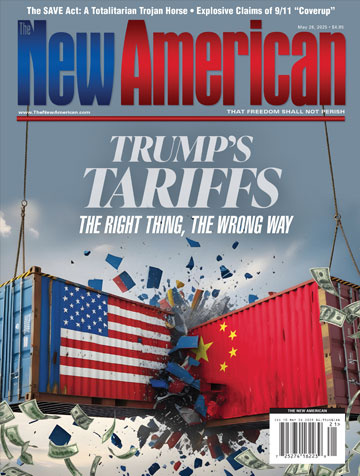
Many millions of Americans dutifully sort their trash, believing that recycling saves the environment and facilitates sustainability. But what if this greentopian ritual not only doesn’t help the Earth, but actually harms it and the economy to boot?
Recycling most plastic, for example, would be a fool’s errand and therefore isn’t done, as even the environmentalist organization Greenpeace admits. What’s more, much “recycled” plastic has in the past been shipped overseas — and then dumped into the ocean.
Reporting on this recently was famed journalist John Stossel, who conducted his own recycling investigation. His conclusions align with what others have learned, too. To wit:
“Recycling aluminum does save energy,” he says in a video report, but “most of the other stuff is impractical to recycle.”
Stossel also states that recycling “paper and cardboard does save trees.” (Whether or not this makes it a good idea is another matter. Note here that the United States now has more forested area than it did a century ago.)
Stossel visited a recycling facility and learned that “huge amounts” of material “from people’s recycling carts … is going to leave as trash.” “The worst is plastic, which for years has been marked with a recycling symbol,” says the journalist. Most of it is not recyclable. Moreover, plastic bags clog the recycling machines, forcing workers to spend hours cutting them from the mechanisms. So how much of our plastic actually is recycled?
Approximately five percent, Stossel found.
The issue? “There are so many different varieties of plastic that they’re almost impossible to sort efficiently,” reported Kite & Key Media last year. “Most of it degrades with each reuse. Making new plastic is actually cheaper than recycling old plastic. And the newest, high-tech methods of recycling it generate carbon emissions 55 times higher than just putting it in a landfill.”
None of this information is new. Stossel mentions that even the left-wing New York Times covered it in an article years ago by science writer John Tierney titled “Recycling is Garbage.” What it’s not, however, is a harmless exercise in futility.
In fact, “My city would save more than $300 million a year if it just stopped recycling,” said Stossel. The reason? “Recycling is an industry that is using increasingly expensive labor to produce materials that are worth less and less,” John Tierney can be heard saying in Stossel’s report. Moreover, because it’s not worth doing the “recycling here, much [waste] is shipped overseas to countries like Malaysia, where it’s just piled up,” Stossel adds. Its fate?
What “they don’t burn, they sometimes dump in the ocean,” says Stossel; in fact, every minute, one garbage truck full of plastic is dumped into the sea.
This pollution by proxy is one reason we have the Great Pacific garbage patch, a vast, floating Texas-sized conglomeration of plastics and other debris. So, ironically, if you care about saving the environment, says Tierney, “put your plastic bottle in the garbage” — which guarantees it will end up not in the water but in a landfill.
But what of landfill space? People believe there’s a lack of it, but even left-wing NPR acknowledged in 2019 that this is a “misconception.” It’s a misconception that birthed the recycling craze, however, and it all began with the 1987 voyage of an infamous garbage barge named the Mobro 4000.
Traveling around the world trying to find a place to unload its trash, the vessel became a major news story and the “poster boy” for our nation’s alleged dearth of dump space. But it was a real load of garbage — that is, the media coverage. A reasonable business endeavor victimized by bad press, the barge’s plight was the result of an unfounded rumor that it was carrying infectious waste.
In reality, “landfill space was and is plentiful,” wrote The New American last year. “America’s trash-disposal needs for the next millennium could be met by digging a landfill covering just 0.1 percent of the land used for grazing in this country, researchers have estimated.” Or, as Reader’s Digest related decades ago, “1,000 years of our nation’s garbage could fit in an area 50 miles square (one sq. mi. per state) piled 200 feet high, the average modern landfill’s height.”
What’s more, regulations today ensure that landfills don’t pollute. Eventually, in fact, they’re “turned into ski hills, parks and golf courses,” Stossel points out.
So given recycling’s irrationality, why does it continue? “They do it because people demand it,” explains Tierney, “It’s a sacrament of the green religion.”
And the kicker concerns a side effect of recycling ritual: “If you rinse a plastic bottle in hot water,” says Tierney, “the net result is more carbon dioxide in the atmosphere than if you threw it in the garbage” (if you care about such things).
Related to this, CO2-wary environmentalists claim recycling counteracts climate change and want to outlaw plastic precisely because it’s mostly non-recyclable. “But plastic often creates less emissions than alternatives,” points out Stossel. Consider, too, that when “Los Angeles mandated recycling, they added 400 polluting garbage trucks,” he adds (video below).
The lesson here is simple: The market — which is democracy applied to economics, as the people determine what goods and services will prevail with their “votes” (daily buying choices) — isn’t perfect. Yet it’s the best general measure we have of a proposal’s rationality. Thus, if the market doesn’t warrant something’s (e.g., recycling’s) existence, we should think twice about it. Apart from basic laws, an idea that must be enforced by government usually isn’t a good idea.
None of this means recycling will end anytime soon. After all, not only does pushing it bring value-signaling pleasure but, says Tierney of the power-lust politicians behind it, “I think they get a charge out of telling people what to do.”




